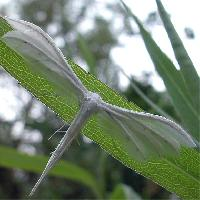
Poids et mesures
| Longueur | 17 mm |
|---|---|
| Envergure des ailes | 34 mm |
Description de l'animal
The White Plume Moth, scientifically known as Pterophorus pentadactyla, is a fascinating and unique species within the Lepidoptera order, which encompasses all moths and butterflies. This moth is particularly known for its distinct appearance, marked by its pure white wings that are not only deeply cleft but also spread out in a plume-like fashion, giving it an ethereal, delicate look that is unlike any other moth species.Native to Europe, including the British Isles, and extending its range into parts of Asia, the White Plume Moth has adapted to a variety of habitats but shows a preference for open, grassy areas. These habitats often include meadows, gardens, and fields, where its larval food plants, such as bindweed (Convolvulus) and other members of the Convolvulaceae family, are abundant.
The wingspan of the White Plume Moth is quite remarkable, ranging between 24 to 35 millimeters. The wings themselves are divided into five distinct plume-like segments, from which the species derives both its common and scientific names ('pentadactyla' meaning five fingers in Greek). This unique structure of the wings allows the moth to navigate through the air with a fluttering, somewhat erratic flight pattern that can be quite captivating to observe.
The lifecycle of the White Plume Moth begins with the laying of eggs on the underside of leaves of its host plants. The caterpillars are green with a slender body, helping them camouflage among the leaves and stems where they feed. After a period of growth, the caterpillars pupate, emerging as adults typically in the summer months. In regions with favorable conditions, the White Plume Moth can produce multiple generations within a year.
Adult moths are nocturnal and are attracted to light, which makes them more visible to observers during the night. During the day, they rest in vegetation, relying on their white coloration to blend in with their surroundings as a form of protection against predators.
The White Plume Moth plays a role in the ecosystem as both a pollinator and a source of food for other animals. While not as efficient as bees or some other butterflies and moths, they do contribute to the pollination of flowers during their nocturnal activities. Birds and bats, among other predators, may prey on these moths, thereby maintaining the balance within their natural habitats.
In summary, the White Plume Moth is a striking species characterized by its distinctive wing structure, pure white coloration, and fascinating lifecycle. Its presence in gardens and fields adds to the biodiversity of these environments, making it a subject of interest not only for entomologists but also for nature enthusiasts who are captivated by the beauty and diversity of moth species.
Nouvelles photos d'animaux
Top 10 des animaux
- Dolphin gull (Leucophaeus scoresbii)
- Diana monkey (Cercopithecus diana)
- Moustached guenon (Cercopithecus cephus)
- Galápagos tortoise (Geochelone nigra complex)
- Russian tortoise (Testudo horsfieldii)
- Japanese macaque (Macaca fuscata)
- Stone loach (Barbatula barbatula)
- Greek tortoise (Testudo graeca)
- Common flying dragon (Draco volans)
- Colossal squid (Mesonychoteuthis hamiltoni)